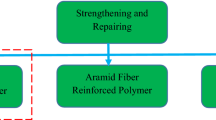Abstract
The paper focuses on the combined effect of Steel Fibre Reinforcement and of Rubber aggregates on the resistance to restrained shrinkage cracking of cement-based mortars. The kinetics of restrained shrinkage cracking of a control mortar is compared both to the one incorporating a single fibre content as reinforcement and to the above fibre reinforcement combined to rubber aggregates substitution. Two rates of substitution were considered in the case of Steel Fibre Reinforced and Rubberized Mortar (SFRRM). The used rubber aggregates are obtained by grinding used tyres, a way that may address the demand for the conservation of a clean environment by recycling an industrial by-product. Fibre-reinforced mortar was based on the control mortar and one metal fibre content was studied: 40 kg/m3 (0.5% by volume). The used fibres have a high bond with the cementitious matrix. SFRRM composites were cast using two contents of rubber aggregates: 20 and 30% by volume replacing mineral aggregates and the one fibre content reported here above (40 kg/m3). Tests were conducted using ring type specimens to simulate restrained shrinkage cracking according to ASTM C 1581-04 standard. Additionally, after the cracking occurred, the development of the crack widths was measured by video-microscope. Ring tests demonstrated that the SFRRM exhibit high strain capacity prior to macro-cracking localization and the effectiveness of rubber aggregates along with their positive synergistic effect when combined with fibre reinforcement to improve resistance to shrinkage cracking. It is a promising solution to improve the durability of large surface area such as pavements and thin bonded cement-based overlays, whose durability is often limited by shrinkage cracking.







Similar content being viewed by others
References
Grzybowski M, Shah SP (1990) Shrinkage cracking of fiber reinforced concrete. ACI Mater J 87:138–148
Mesbah HA, Buyle-Bodin F (1999) Efficiency of polypropylene and metallic fibres on control of shrinkage and cracking of recycled aggregate mortars. Constr Build Mater 13:439–447
Hossain AB, Weiss J (2004) Assessing residual stress development and stress relaxation in restrained concrete ring specimens. Cem Concr Compos 26:531–540
Bonnet S, Turatsinze A, Granju J-L (2004) A crack-resistant cementitious composite: synergy between steel fibres and rubber aggregates. Bulletin des Laboratoires des Ponts et Chausses 250–251:43–53
Shah HR, Weiss J (2006) Quantifying shrinkage cracking in fiber reinforced concrete using the ring test. Mater Struct 39:887–899
Weiss J, Shah HR (2002) Restrained shrinkage cracking: the role of shrinkage reducing admixtures and specimen geometry. Mater Struct 35:85–91
Turatsinze A, Bonnet S, Granju J-L (2005) Mechanical characterisation of cement-based mortar incorporating rubber aggregates from recycled worn tyres. Build Environ 40:221–226
Ramakrishnan V, Coyle WV (1983) Steel fiber reinforced super-plasticized concretes for rehabilitation of bridge decks and highway pavements. DOT/RSPA/DMA-50/84-2
Balaguru P, Shah SP (1985) Alternative reinforcing materials for developing countries. Int J Dev Technol 3:87–105
Gopalaratnam VS, Shah SP, Batson G, Griswell M, Ramakrishnan V, Wecharatana M (1991) Fracture toughness of fiber reinforced concrete. ACI Mater J 88(4):339–353
Shah SP, Wang J, Weiss WJ (2000) Shrinkage cracking—can it be prevented. Concr Int 20(4):51–55
Cyr M, Ouyang C, Shah SP (2003) Design of hybrid-fiber reinforcement for shrinkage cracking by crack width predictions. In: Brandt AM, Li VC, Marshall IH (eds) Brittle matrix composites, vol 7. Woodhead Publishing Limited, London, pp 243–252
Topcu B (1995) The properties of rubberized concretes. Cem Concr Res 25(2):304–310
Toutanji HA (1996) The use of rubber tire particles in concrete to replace mineral aggregates. Cem Concr Compos 18:135–139
Segre N, Joekes I (2000) Use of tire rubber particles as addition to cement paste. Cem Concr Res 30:1421–1425
Nguyen TH, Toumi A, Turatsinze A (2010) Mechanical properties of steel fibre reinforced and rubberised cement-based mortars. Mater Des 31(1):641–647
ASTM C1581-04 (1999) Standard test method for determining age at cracking and induced tensile stress characteristics of mortar and concrete under restrained shrinkage. Constr Build Mater 13:439–447
See HT, Attigole EK, Miltenberger A (2003) Shrinkage cracking characteristics of concrete using ring specimens. ACI Mater J 100:239–245
Carlson RW, Reading TJ (1988) Model of studying shrinkage cracking in concrete building walls. ACI Struct J 85(4):395–404
Author information
Authors and Affiliations
Corresponding author
Rights and permissions
About this article
Cite this article
Nguyen, TH., Toumi, A., Turatsinze, A. et al. Restrained shrinkage cracking in steel fibre reinforced and rubberised cement-based mortars. Mater Struct 45, 899–904 (2012). https://doi.org/10.1617/s11527-011-9806-x
Received:
Accepted:
Published:
Issue Date:
DOI: https://doi.org/10.1617/s11527-011-9806-x




